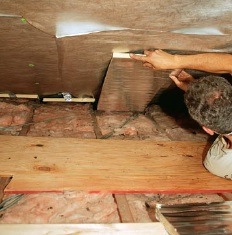
Image Credit: Fine Homebuilding
The legislature of the state of New York has infamously earned a reputation for gridlock and theatrics. But the reality is that both the Assembly and the Senate in Albany have been moving ahead with the business of the day, including programs designed to help New York address both its economic and ecological issues.
One step in that direction is the Senate’s passage last week of the Green Jobs/Green NY Act of 2009 (S5888), which has already passed in the Assembly and almost certainly will be signed by Governor David Paterson.
The Green Jobs initiative, which is designed to provide upfront financing for energy-efficiency retrofits to both homeowners and businesses, is similar to programs already offered by other jurisdictions, including municipalities in California, Colorado, and Virginia, and the city of Babylon, New York, on Long Island. Even in the U.K., the city of London is trying to address the energy inefficiencies in its aging housing stock by offering homeowners subsidies for weatherization improvements.
Selling emissions credits
Funding for the statewide Green Jobs program will come from sales of carbon emission credits offered through the Regional Greenhouse Gas Initiative, for which several states in the Northeast are developing a cap-and-trade program for power-plant emissions. A summary of the initiative by State Senator Bill Stackowski notes that the legislation allocates $112 million from RGGI cap-and-trade auctions, which have raised $126 million over the past two years.
The loans will be administered by the New York State Energy Research and Development Authority, which focuses primarily on the reduction of petroleum consumption but also on research into the environmental effects of energy consumption, the development of renewable resources, and other technology innovations. The loan limit for each residential customer is $13,000, and $26,000 for each business. Loan costs will be added to participants’ monthly energy bills, although the energy savings from each retrofit – which should reduce usage by 30% to 40% – is expected to be larger than the loan payment.
NYSERDA also will collaborate with the Department of Labor on developing a training program for retrofit workers that will help to create as many as 14,000 jobs in that sector.
A recent Green Inc. blog post in the New York Times points out that even though research shows that retrofitting buildings is one of the quickest and most cost-effective ways to reduce overall energy use, it has been relatively slow to catch on, particularly in the commercial building realm, where obtaining financing for large-scale improvements is the biggest barrier to getting the work done.
Other retrofit initiatives
In the residential arena, meanwhile, progress on retrofits is advancing not only with municipal and statewide initiatives like those mentioned above, but also with the stimulus-funded Weatherization Assistance Program and private alliances such as one announced last week between Habitat for Humanity and electric-utility giant Exelon Corporation, which have teamed up to retrofit 70 low-income homes in Exelon service territories in Illinois, Pennsylvania, and Texas.
Exelon, whose nuclear power plants serve 5.4 million customers in the mid-Atlantic states and the Midwest, has donated $300,000 to fund the program, will provide technical and training expertise over the next 10 months, and will donate about 7,000 Exelon employee volunteer hours for the program.
The cost of the retrofits will range from about $2,000 to $8,000 per home and include improvements such as weatherstripping, caulking, adding or replacing door seals, installing low-flow toilets and showerheads, replacing water heaters and furnace filters, installing CFL bulbs, and insulating attics, basements, and outer walls. The program partners estimate the improvements will save homeowners between 12% and 25% on their energy bills.
Weekly Newsletter
Get building science and energy efficiency advice, plus special offers, in your inbox.













0 Comments
Log in or create an account to post a comment.
Sign up Log in